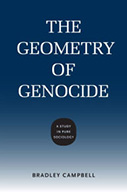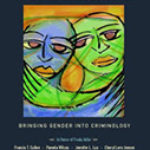THE GEOMETRY OF GENOCIDE: A STUDY IN PURE SOCIOLOGY

Author: Bradley Campbell
Publisher: Charlottesville, VA: University of Virginia Press, 2015. 272p.
Reviewer: William R. Pruitt | January 2017
Genocide is a multifaceted issue often occurring as a result of social, psychological, criminological, and economic factors. Most theorists of genocide agree that no single theory could explain the complex nature that leads to the world’s most heinous crime. Theorizing on genocide is a relatively recent academic endeavor. Research on the Holocaust was sparked in the 1960s, but examining genocide as a phenomenon beyond the Holocaust did not begin until the early 1990s.
In the past twenty-five years much has been written about genocide and its effects on victims, perpetrators, society, and beyond. Multiple theories have been developed to help explain how and why certain situations end in the attempted annihilation of a group of people. No theory has been able to encompass the entirety of the topic and offer an explanation that fits each possible example of genocide. Into this field comes Bradley Campbell and his theory on the geometry of genocide. As a contribution to our understanding of genocide, the geometry of genocide is a new way of thinking about genocide, and processing it.
If Campbell saw his theory in this way his book would pass as a valuable contribution, but Campbell offers his theory as the theory of genocide, not a theory of genocide. While any theorist would have to believe wholeheartedly in his creation, ignoring other factors and explanations weakens his argument. The geometry of genocide is an intriguing way to look at genocide and its causes, but ignoring other factors tends to raise more questions than it answers.
Any study of genocide must begin with defining the concept to be examined. There are myriad definitions of genocide, especially when one enters the social science field. The legal definition of genocide offered by the United Nations and used by most countries is “any of the following acts committed with intent to destroy, in whole or in part, a national, ethnical, racial or religious group, as such: (a) Killing members of the group; (b) Causing serious bodily or mental harm to members of the group; (c) Deliberately inflicting on the group conditions of life calculated to bring about its physical destruction in whole or in part; (d) Imposing measures intended to prevent births within the group; (e) Forcibly transferring children of the group to another group.”
The main elements of this definition include the fact that genocide is limited to groups based on nationality, ethnicity, race, or religion. This means groups targeted due to politics or gender are not considered acts of genocide. Also, genocide includes acts of killing, acts that cause serious bodily harm, acts intended to prevent birth, and moving children from one group to another. These acts are all designed to weaken or destroy a group of people by removing them completely (killing), by removing the capacity to grow (prevent birth), or by removing future generations (moving children). This definition has not pleased everyone since its inception in 1949. Many social scientists have expanded the definition to include political groups, gender, and other minority categories.
Campbell has also altered the legal definition to fit the purposes of his study. Campbell defines genocide as “one-sided, ethnically based mass killing” (p. 4). This definition automatically limits the act of genocide to acts of killing — ignoring the other methods of genocide recognized by the UN (see (b) – (e) above). This limitation makes logical sense because when the public think of genocide they usually think of mass killings. The other methods of genocide are less common and less well understood. Even those studies that include all methods of genocide in their definition tend to focus on the killing aspect.
The other limitation raised by Campbell’s definition refers to what groups would qualify for the genocide label. Campbell limits his definition to ethnically based mass killings. He uses ethnicity in a very broad sense though. Ethnicity is used to refer to “cultural groups characterized by a notion of common descent” (p. 205). Under this definition, it appears that all of the same groups protected by the UN definition would be covered by Campbell as well, including race, ethnicity, nationality, and religion. In fact, his case studies cover most of these groups. The expansive use of the word ethnicity is appropriate, but unfortunately Campbell’s definition of ethnicity is hidden in the notes section of the book at the end. For such an important concept as a key term in a definition, this should have appeared in the main text. Those who forgo the endnotes will likely be confused by the use of the term ethnicity when Campbell starts discussing religiously and racially based genocides.
The crux of the geometry of genocide is to be found in pure sociology. As explained by the author, pure sociology focuses only on the social, and excludes other variables like psychology. “Pure sociology explains human behavior with its social geometry: its location and direction in social space and social time” (p. 8). Social space refers to the way in which people relate to one another; people can be intimates or strangers based on their social space. A change in social time is a social change like an increase or decrease in intimacy. Taken together, changes in social space and social time explain the occurrence of genocide.
The root causes of genocide according to Campbell lie in either overdiversity or under-stratification and social distance. In social time, overdiversity occurs when ethnic groups that were previously separated come into contact with each other leading to ethnic conflict and possibly genocide. Under-stratification occurs when a high status group is threatened or a low status group experiences a rise in status. In social space, the greater the social distance the greater the likelihood of genocide, because the victims and perpetrators lack similarities and interdependence. When overdiversity or under-stratification and social distance increase, the possibility of genocide increases too.
Campbell then proceeds to apply his theory to several case studies of genocide in an attempt to highlight how his theory works in practice. The case studies include massacres against Native Americans in California, specifically the Yuki and Yana tribes; Muslims and Hindus in India, specifically in Gujarat; Muslims in Bosnia; Tutsis in Rwanda, specifically in Nyakizu prefecture; and finally, Jews during the Holocaust, specifically in Lithuania. While Campbell is able to overlay his theory onto each of these case studies, it seems that he misses the forest for the trees. His analysis is so focused on specific sub-parts of an overall genocide that the macro understanding of the genocide as a whole is missed.
Some examples will be important. When discussing the Rwandan genocide, Campbell focuses on the Nyakizu prefecture. But by doing so it is not clear that his theory would apply to the entire Rwandan genocide, or merely this one sub-set of the genocide. Is he explaining the Rwandan genocide or how the genocide occurred in Nyakizu? Similarly, when discussing the Holocaust persecution of Jewish people, Campbell focuses on the situation in Lithuania. Is he trying to explain the Holocaust or how the massacres occurred in Lithuania? With all of the literature on the Holocaust it is difficult to believe that Campbell is trying to explain the entire genocide, but is indeed only focusing on one area where his theory appears to fit. Though one still has questions about the fit, when he tells the story of one Lithuanian Jew who was not murdered because he was close to the potential perpetrator. The evidence of closeness was though only that the Jewish man spoke fluent Lithuanian. This seems like a tenuous thread on which to hang such a momentous decision as whether or not to kill this man. It also raises questions about other Jews who spoke fluent Polish or German or French, and why that was not enough to save them.
Campbell’s decision to not engage with any discipline other than sociology or with any of the other genocide theories tends to weaken his argument. Campbell has also decided not to engage with any negative cases, i.e., genocides that would not fit his theory. He points out that his theory is probabilistic not deterministic, but recognizing negative cases would be better than pretending they do not exist. For example, when he discusses the genocide in Bosnia, he does not refer to Srebrenica, the only legally recognized genocide occurring during the Bosnian war. Srebrenica was a UN safe zone designed for Muslims to be protected from Serbian onslaught. The town was protected by UN troops, and had resettled close to 40,000 Muslims from other parts of Bosnia. This would appear to create greater social distance, because the Muslims had been moved away from living with Serbs and were in fact in Bosnia, not Serbia, at the time. But that did not stop the Serbian army from attacking the safe zone and killing upwards of 8,000 Muslim men. Similarly, the Ottoman Empire was deporting thousands of Armenians during World War I to the Syrian Desert, thus increasing social distance, but genocide still occurred. How does the geometry of genocide explain this seemingly contrary behavior?
This question of contrary behavior is natural to ask because Campbell spends much time trying to explain one type of contrary behavior in genocide. He is concerned with individuals who both kill and also act as rescuers during the genocide. He posits that the reason one person could be both killer and rescuer is due to the social distance between themselves and the victim. The greater the social distance the easier to kill, the closer they are to the victim the more likely they will act to rescue. This however does not answer the other question of genocide, why do some people not participate at all or are only rescuers? Campbell mentions Paul Rusesabagina, the man made famous in the movie Hotel Rwanda, who saved over 1,000 Tutsis from the genocide. Unfortunately, Campbell does not attempt to explain Rusesabagina’s behavior using his theory. Why did Rusesabagina save so many Tutsis with whom he had no connection to at all? Social distance would predict that it would be more likely for him to be a perpetrator against these individuals.
Offering an explanation for negative cases like Srebrenica and Rusesabagina would potentially strengthen the theory by recognizing its gaps. Instead, anything that does not fit with the theory seems to be ignored. Campbell is quite clear that his goal is to focus solely on sociology, and thus on no other possible explanation for genocide. As an author he can limit his scope however he likes, but as a theorist he should be willing to recognize gaps in his theory where questions may arise. The questions will arise regardless, and sometimes a good offense is a better defense.
Overall, the geometry of genocide is a valuable addition to the theories on genocide that currently exist. It offers a way of examining genocide in its social setting. Combining it with other existing theories will likely help increase our understanding of genocide. Criticisms offered here are merely designed to strengthen the theory by encouraging further research. Campbell ends his book on a hopeful note. As the peoples of the world increasingly rely on each other and close the social distance, “genocide is destined for annihilation” (p. 203). I fervently hope Campbell is right on this point.
William R. Pruitt, J.D., Ph.D., Assistant Professor of Criminal Justice, Virginia Wesleyan College


